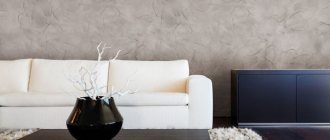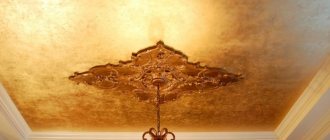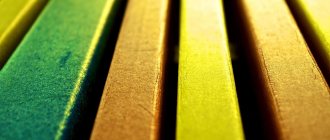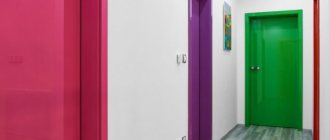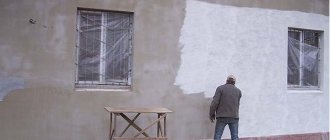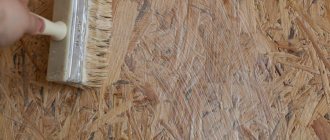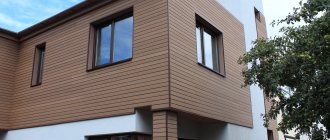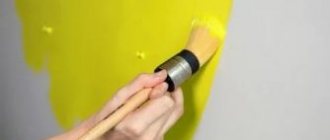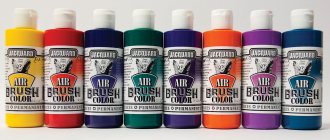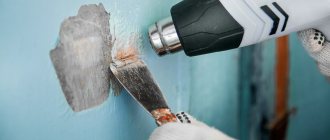Polymer paints have become widespread. Their demand is explained by the large assortment, ease of use and aesthetics of the resulting coating. Information about latex or acrylic paint – which is better and what is the difference between the compositions – will help you choose the appropriate option.
Find out if latex paint is better.
What components does the paint consist of?
Water soluble paint
The composition of all water-soluble rubber-based paints is identical and includes:
- The binder is one polymer or a mixture of several that make up the base. They provide surface adhesion, durability and resistance to negative impacts.
- Pigment is a powdery substance in the form of a suspension that gives color to the composition.
- Filler - has a structure similar to pigment, but its molecules are larger. Responsible for such properties of the finishing material as dullness or glossy shine, and also enhances the durability of the coloring matter
- Solvent (or water) - a liquid in which coloring particles are distributed
- Additional components - additives that impart new physical and chemical properties and improve the properties of latex
Latex paint samples
When applied to a surface, the liquid evaporates after some time. Particles of polymer and coloring pigment are combined to form a film that is elastic and durable.
The aqueous dispersion phase of all latex paints consists of synthetic rubber particles stabilized by emulsifiers, which can be:
- acrylic
- urethane
- siloxane
- polyvinyl acetate
- butadiene-styrene
Types of polymer binders
Among chemists, the term “latex” has two meanings. One is Hevea juice or its synthetic substitute made from isoprene, urethane, styrene butadiene, acrylic, etc. polymer. The second, derived from English. latex is a dispersed emulsion of polymer particles in water. Acrylic paint is nothing more than an emulsion of dispersed particles of acrylic or its derivatives: acrylates (polymers) dissolved in water, i.e. This is pure latex paint, if you adhere to the official terminology.
To avoid confusion in the future, let us clarify what is meant when a comparison is made as to which paint is better, latex or acrylic. Modern water-soluble paints may contain acrylic copolymers (acrylates) or styrene-butadiene copolymers as binders. A class of paints based on a dispersion of acrylates dissolved in water is called “acrylic paint”. And dyes with butadiene-styrene copolymers began to be called “latex paint.”
A different name for a water-based emulsion does not change the essentially identical composition of the components of the coloring matter, which includes:
- binders - substances responsible for adhesion, resistance to mechanical stress, service life of the applied paint layer and other characteristics, both physical and operational. They can be polymers or copolymers (the composition contains several types of polymers, including both acrylates and styrene-butadiene polymers);
- solvent - in water-emulsion dispersions it is water;
- pigments or colors - fine powder or liquid that colors the composition in any color or tone (more than 200 varieties);
- stabilizers - additives that improve the quality characteristics of paint or determine the scope of its application (for external or internal work, application to metal, wood, glass, etc.);
- fillers - substances responsible for the level of gloss of the surface of the applied paint layer (matte, semi-matte, glossy, etc.).
Latex paint and its types
Styrene-butadiene emulsion
The binding element in latex dyes is synthetic rubber based on copolymers.
It gives the raw materials for dyeing the following characteristics:
- Resistant to stains and repels dust particles
- Quick drying on surface
- The ability to evaporate moisture from the painted area due to the fact that the latex layer allows oxygen to pass through
- The saturation of pigments, which makes the color of such paints brighter
- No toxic components (allowed to be used for interior decoration)
- Elasticity, modeling a flat surface by filling all unevenness and roughness
- Economy in use
Latex paint
The types of paints and varnishes, depending on the components in the composition, are presented in the table.
| View | Characteristics | Which finish is it suitable for? |
| Polyvinyl acetate (water-based or water-dispersed) | Made from PVA glue, non-toxic, provides good adhesion to the surface. Disadvantages: unstable, easily washed off with water | For dry rooms |
| Butadiene-styrene | Resistant to water, but fades easily in sunlight | For bathrooms, toilets, corridors, basements |
| Acrylic | High-quality, suitable for interior work, facade finishing and painting exterior elements | For interior and exterior decoration |
| Acrylic-silicone | Reliable facade finishing with high durability | For facades and rooms with high humidity |
| Washable | Based on an acrylate binder polymer | For interior work |
| Rubber acrylate-latex | Creates a coating that is resistant to moisture, UV radiation, and temperature fluctuations, elastic and quick-drying. | For covering tennis courts, swimming pools, running tracks |
For interior work the following are most often used:
- vinyl
- acrylic
- dripless
- textured
- dense
Latex finishing compounds can give different finishing effects: matte, glossy or semi-matte.
Latex materials used:
- For external work (painting facades)
- For interior decoration (for walls and ceilings)
- For painting the floor
- For surface waterproofing
- Universal
What disadvantages are typical for both paints?
The disadvantages of water-based paints and varnishes containing latex are identical:
- Good resistance to moisture does not exclude the appearance of fungus on the painted surface. To eliminate this drawback, it is enough to treat the walls with a primer.
- Low temperatures have a detrimental effect on paints, but this disadvantage is least evident in acrylic paints and is absent in such a variety as façade.
Paints have many more positive properties than disadvantages, but in order to decide which specific composition to purchase, it is necessary to consider the features of each material separately.
Acrylic paint and its types
Acrylic coatings
The binders that underlie acrylic paint are acrylic copolymers: silicone, vinyl, styrene. Manufacturers usually write this on the packaging – 100% acrylic.
Characteristics of paint based on acrylic polymer:
- elasticity
- high adhesion (adhesion to the surface)
- vapor permeability
- resistance to water and UV radiation
- range of colors up to 5 thousand shades
- paint brightness and durability
- safety of use (contains no toxic substances or heavy metal salts)
This coating does not crack due to sudden temperature fluctuations or abnormal temperatures, is easy to use and is used for most painting jobs. Acrylic films do not protect against fire. [/wpsm_box]
Painting with latex paint
There are the following types of acrylic finishes:
- glossy (dissolves under the influence of ordinary water)
- glyphthalic (contains acrylic resin, used for finishing residential premises)
- special (does not require preliminary priming, anti-corrosion, most expensive)
Can be applied to surfaces from:
- concrete
- glass
- metal
- stone
- bricks
- wood (fibreboard, MDF, chipboard)
- plaster
What is the difference between acrylic and latex paints
Acrylic paints
Strictly speaking, it is impossible to draw a clear line between the two acrylic and latex paints: they have similar compositions. At its core, the first is a variety of the second: acrylic is a type of latex.
It is almost impossible to distinguish the two compositions visually. The difference is visible only during use or after reading the information about the composition on the package.
Both acrylic and latex paints have the following general characteristics:
- durability of use
- they can be applied to any coating, regardless of the relief
- durability and resistance to moisture
- UV resistance
- allow air to pass through (there will be no bubbles during application)
- harmless water acts as a solvent
- impart a silky texture to the painted surface
- non-toxic
However, latex paints due to the styrene-butadiene dispersion:
- They have greater elasticity, so they can be used for painting wallpaper.
- Visually give painted surfaces a more attractive appearance
- Can easily tolerate wet cleaning or other exposure to water
Interior acrylic paint
Acrylic paints are more expensive, but they also last longer and are more durable. Latex paints are best used for interior work in dry rooms without bright lighting; for exterior work it is best to use latex-based acrylic paints.
The difference between the two compositions can be most clearly seen by comparing water-based and acrylic paints. The former are optimally suited for indoor dry spaces, while the latter can be used anywhere and are not afraid of moisture.
Sellers of paint and varnish materials often offer customers an acrylic-latex mixture. It is cheaper than pure acrylic because it contains styrene-butadiene emulsion.
According to quality and physico-chemical characteristics, rubber paints are distributed from the best down in descending order as follows:
- Acrylic latex
- Acrylic-latex mixture
- Polyvinyl acetate
- Butadiene-styrene
- Acrylic silicone
The main differences between paintwork materials
There are certain differences between acrylic and latex materials. Thus, acrylic substances are often called more durable and of higher quality compared to latex ones. At the same time, they cost more. However, in reality, the properties of the materials are largely the same.
See also
Types of heat-resistant paints for muffler and painting procedure
By composition and properties
Previously, paints had significant differences in composition. Although both types of materials were made from water, acrylic dyes used acrylic resin as a binder, while latex dyes used latex or milk from the rubber tree.
Today, almost all manufacturers have eliminated the use of natural latex. Therefore, dyes, which are called latex, contain artificial thermoplastic resins, reminiscent of acrylic materials. As a result, the properties of the paints largely coincide. The coatings are washable and breathable. At the same time, there are a number of differences.
By purpose
Acrylic paint has a wide range of applications. It can be used without restrictions. The composition is applied to any materials and used in different places, including the exterior of buildings. At the same time, latex substances are prohibited from being used for façade work.
Also, they should not be applied in rooms with high humidity.
In terms of resistance and durability of the coating
The durability of the coating is influenced by a number of factors:
- wear resistance;
- UV resistance;
- resistance to high humidity.
If you focus on ideal operating conditions, both types of dyes differ in approximately the same performance. They are about 20 years old. However, in practice, acrylic coatings are more durable. Latex substances do not withstand exposure to the sun and high humidity.
Covering power
This term refers to the ability of a dye to cover the original shade of a surface. To indicate this parameter, a scale from 1 to 5 is used. The specific indicator depends on the ratio between binders and pigment. It is also affected by the size and number of particles.
Expert opinion
Zakharova Irina Yurievna
Cleaning professional with 15 years of experience. Our best expert.
Ask a Question
The higher the hiding power, the less paint you need to spend. This means that it is possible to purchase a more expensive material with high coverage parameters and at the same time save money on the number of layers.
Acrylic and latex dyes are often classified as opacity class 2. However, some European companies also offer Class 1 substances. Such materials allow you to get by with applying 1 layer of paint.
Moisture resistance and fading
Paints differ in moisture resistance parameters. The surface with latex material can be wiped with a damp cloth. In this case, the acrylic substance can be applied in rooms with high humidity.
Resistance to fading also has certain differences. Latex substances are afraid of ultraviolet radiation. They fade quickly when exposed to sunlight. Acrylic paints can be left in open areas for 10 years. At the same time, they will not lose their original shade.
See also
Types of viscometers for paint, how viscosity is measured and how to determine it
For safety of use
Modern dyes are considered harmless. However, both acrylic and latex materials contain chemical components. Therefore, when using them, it is important to adhere to basic safety rules and use personal protective equipment. This will help avoid negative health consequences.
Cost and material consumption per 1 square meter
Latex dyes made from styrene-butadiene copolymers are cheaper than acrylic materials. The price difference is approximately 15-65%.
At the same time, it is useless to indicate specific numbers, because they depend on many factors. These include the following:
- brand popularity;
- number and type of stabilizing components;
- type of fillers.
When carrying out repair work, it is necessary to take into account the consumption of material. This parameter is affected by the elasticity of the substance. The higher this indicator, the less dye is spent per 1 square meter. When using acrylic paints, this parameter is 0.2-0.25 kilograms, latex - 0.15-0.2.
Is it possible to mix
Mixing latex-based paints
The question of whether it is possible to mix acrylic and latex paint is asked to craftsmen quite often. Experts do not recommend conducting such experiments. The composition of industrial dyes is clearly verified, so when emulsions interact, it is difficult to predict the final result.
Both paints are water-soluble, so there will be no problems with the mixing process itself. However, the concentration of the components will change, which will change their final physicochemical characteristics.
If we talk about applying one type of coating to another, then this is possible. In this case, it is preferable to make the bottom layer acrylic and the top layer latex. Acrylic provides reliable adhesion to the surface, and copolymers make it possible to wash painted areas or protect them from rain.
The only combination that is best avoided: painting with pure acrylic over an acrylic-silicone layer - the paint simply will not take.
How to choose latex paint
Paint for interior and exterior use
When choosing a paint and varnish material, you need to proceed from the purpose of the finish. Thus, paints for interior work are not suitable for painting facades, and substances for exterior painting will not add comfort to the premises.
It is not recommended to use ceiling paint when painting walls - it has low wear resistance and wears off quickly.
When purchasing paint, you need to pay attention to the following parameters:
- Degree of whiteness (if white pigment is used) - especially important for painting the ceiling
- Finishing effect - what kind of coating the paint provides: glossy, matte or semi-matte
- Consumption per 1 m2 . Indicated by the manufacturer on the packaging. When purchasing, you should take into account not only the area of work, but also the number of layers of coating.
- Wear resistance - determines the durability of the finish with constant physical contact. On the packaging the parameter is indicated as the number of abrasion cycles, which must be at least 3000
- Hiding ability is a property that determines how strongly the pigment covers the original color of the surface.
- Thickening rate - the higher it is, the less likely it is to drip on vertical painted surfaces
- Resistance to moisture - important to consider when finishing rooms associated with the use of water (bathrooms, toilets, utility rooms)
Water-dispersed acrylic paint
On the packaging of high quality acrylic latex paint the following marks are possible:
- “resistant to dry abrasion” (can be wiped with a dry cloth and remove dust with a vacuum cleaner or broom)
- “for dry rooms” (assuming a low operational load of the surface, there should be no source of moisture nearby)
- “indelible” (can be washed, but stains and streaks will remain on the film)
- “washable” (contains dirt-repellent components, wet cleaning is possible)
What's better?
To choose the right paint for walls or other types of surfaces, it is important to consider the following:
- Acrylic paints are considered universal. This means that they can be used without restrictions indoors or outdoors. If there are special stabilizing additives, such substances can be used in rooms with high humidity - in the kitchen or bathroom. Water resistance parameters are often indicated on the packaging.
- Latex paints can hardly be called universal. They may only be used for painting interior spaces. In addition, such substances are not recommended for use in conditions of high humidity or sudden temperature changes. At the same time, latex paints are cheaper. That’s why they are often chosen for corridors and closets.
How to use it correctly
Painting with water-soluble paint
When using paints based on acrylic or with the addition of copolymers, work is carried out in the following sequence:
- The surface is prepared for painting: cleaned of old paint and dirt
- If necessary, strengthen with a primer and eliminate unevenness and roughness with putty.
- Treated with sandpaper for leveling
- The first layer of paint is applied with a roller (not foam rubber) or a brush, painting all hard-to-reach places with it.
- You need to paint not in sections (this will make the coating uneven), but in continuous lines from one edge to the other
- Let dry, then apply 1 or 2 coats. There should be no streaks left on the surface. The average polymerization time of the compositions is 5–6 hours at a temperature of +20 degrees
When strengthening surfaces, you can use not a primer, but the same paint diluted with water in proportions of 1 to 5.
The quality of latex paint depends on:
- proper surface preparation
- quality of paint and varnish material
- selection of application tool
- compliance with painting technology
Choosing between glossy and matte paints
Semi-matte acrylic emulsions
On a cleaned surface, latex-based paint gives the following effect:
- glossy
- matte
- semi-gloss
- semi-matte
- completely matte
- absolutely glossy
When performing interior work, the gloss parameter must be taken into account, since different textures have different characteristics and change the perception of the room.
Semi-matte and semi-gloss materials are optimal for finishing walls and ceilings.
Thus, glossy surfaces visually expand the space and are less susceptible to dirt and dust settling. However, gloss requires perfectly smooth surfaces; it does not hide defects and loses its attractive appearance with frequent washing.
Matte paint, on the contrary, hides unevenness well and is easy to clean, but dirt and dust accumulate on it more quickly. In addition, visually, a space where the walls or ceiling are matte looks smaller and darker.
Consumption of paint and varnish material
Painting non-woven textured wallpaper
When calculating the required amount of paint, take into account the area and texture of the surface to be painted.
For acrylic enamel, average consumption rates are: for smooth surfaces - 185 g/m2, for uneven or textured surfaces - 200 g/m2. Even more latex-based acrylic will be needed to paint non-woven wallpaper (up to 250 g/m2).
To reduce material consumption, it is better to use a spray gun or roller with a pile of up to 3–5 mm, for textured wallpaper - up to 7 mm.
To paint the facade you will need at least 185-200 g/m2 of material. If decorative plaster is to be painted, then more raw materials will be needed - up to 250 g/m2. The maximum consumption of acrylic enamel is for decorating walls: the figures exceed 1 kg per square meter, plus a reserve of 5–7%.
Paints from foreign manufacturers
Caparol paint
The best manufacturers of latex paints for interior and exterior work are still considered to be foreign companies that specialize in paints and varnishes.
Tikkurila
Joker paint from Tikkuril
Tikkurila A world-famous Finnish company began producing water-based paints back in the 1950s and has not lowered the quality bar to this day. Latex paints and varnishes from this company are safe for humans, non-toxic, and dry in 1.5–2 hours. One liter of paint is enough for approximately 8 m of surface.
The most popular latex-based Tikkurila products:
- Euro 2 . Used for painting ceilings, children's rooms - the composition includes only environmentally friendly materials
- Euro 12 . A variety with increased wear resistance, suitable for painting walls in the kitchen and hallways
- Euro Facade Aqua . Suitable for painting facades, contains silicone
- Luya . Used for interior work, prevents the formation of mold on walls
- Euro Sealing . Designed for painting ceilings.
Akzo Nobel
British paint "Dulux"
Akzo Nobel A UK manufacturer that produces latex paints under the Dulux brand.
Popular products: Creations Moonlight (ceiling), Latex Matt (matte interior paint), Brilliant White (high vapor permeability).
Manders
Paint “Little Green from Manders”
Manders is a world-famous British manufacturer known for its wide range of color choices.
Noteworthy: Intelligent Exterior Eggshell (water-based for painting wood and metal products) and Masonry Paint (for surfaces made of brick, stone, plaster).
DAW SE
Samtex 7 ELF paint
DAW SE The German company that produces the Caparol paint brand pays special attention to the film’s resistance to wear.
The highest quality products: Samtex 20 ELF (for interior coatings), Aqua-inn N°1 (matte for walls and ceilings), SeidenLatex (for painting areas with high surface load).
Advantages of two compositions
Two CMs are made on a water basis. Therefore, they are characterized by general positive properties. It is impossible to visually distinguish the two coatings. Discrepancies appear during operation and when the constituent elements written on the can become known. General positive qualities:
- The coating resists the UV rays of the sun, which allows you to maintain the brightness of the shade. Some latex compounds lose color saturation over the course of their service life;
- there is no toxic odor or fumes harmful to health at the time of painting and throughout the service life;
- the covering layer is breathable, which eliminates the appearance of bubbles on the painted base;
- water in the composition is an environmentally friendly and safe solvent;
- the elastic covering layer fits well on surfaces of complex configuration;
- The coating of both compositions is silky.
Russian manufacturers
Russian brand paint "Lakra"
There are quite a lot of companies producing paints using modern technologies in Russia today.
The most famous brands:
- Parade . The paints can withstand wet cleaning and are durable - the service life of the coating is more than 10 years. They are divided into segments: Classic, Professional and Delux. We manufacture façade and interior products for walls and ceilings
- Olimp . Produces paints: Alpha (matte for ceilings), Beta (for painting walls), Delta (can be used for painting non-woven wallpaper), Elastic (fills surface roughness, wear-resistant, high hiding power)
- Lakra . Products: Interior Paint Latex Base A LAKRA PROF IT (suitable for painting walls in the living room, bedroom), Moisture-resistant White (for corridors), Washable White (for kitchen, office)
Aqueous polymer dispersions
Aqueous dispersion (D) is a system consisting of two mutually immiscible liquid phases, one of which is dispersed in the other as a dispersed phase, the second (water) contains the first as a dispersion medium.
The most popular product on the Russian market is styrene-acrylic dispersions (SA-D). They are obtained by copolymerizing acrylic acid esters with styrene. A large range of such binders is developed and synthesized using modern technologies and is well suited to the requirements of various industries. These emulsions form elastic, vapor-permeable coatings that have high light and weather resistance, have high adhesion (cohesion) to many types of substrates due to the small particle sizes (0.05 - 0.15 microns), and penetrate deeply into porous substrates, thereby strengthening them.
Due to its positive properties, SA-D is widely used:
- in the production of adhesives, mastics for gluing almost any materials used in construction (wood, linoleum, styrofoam boards, ceramic tiles, etc.);
- in the paint and varnish industry (production of paints, varnishes, putties, primers, enamels, etc.). SA-D in paints form films with excellent appearance, high hardness and deformation-strength properties using a minimum amount of traditional coalescents and other additives;
- in the production of printing inks and varnishes, promoting abrasion resistance, improving printing properties and coating quality;
- for impregnation of nonwoven materials, giving them water-repellent properties, etc.
Price
Marshall paint
Foreign-made paints and varnishes are expected to be more expensive than their Russian counterparts, but their quality is much higher. The minimum price for Russian-made acrylic enamel is about 200 rubles per 1 liter. The cost of foreign quality products that will last a long time starts from 1,500 rubles.
The average cost of the most popular latex materials is presented in the table.
| The product's name | Cost, rub. |
| Tikkurila Euro 2 | from 740 |
| Tikkurila Euro 12 | from 1500 |
| Tikkurila Euro Facade Aqua | from 3000 |
| Tikkurila Luya | from 1500 |
| Caparol Samtex 20 ELF | from 600 |
| Caparol SeidenLatex | from 700 |
| Tikkurila Euro Sealing | from 1000 |
| PARADE DELUXE Brilliant Silky Shine | from 5000 |
| PARADE CLASSIC W1 Ideal ceiling | from 300 |
| PARADE PROFESSIONAL E1 SUPERWHITE | from 1500 |
| Lakra interior | from 700 |
| Facade lacquer | from 1150 |
| Varnish for walls and ceilings | from 500 |
| Olympus Alpha | from 400 |
| Olympus Beta | from 300 |
Interior latex paint
With the cost of paint materials so high, one way to save money is to purchase leftover paint through social networks or online bulletin boards.
A person who bought more material than he needed can sell a container of the required volume on Avito much cheaper than the store offers. Another way to reduce the cost of purchasing raw materials is to purchase them in wholesale construction markets, warehouses or online.
Separating and comparing acrylic and latex raw materials is nothing more than a common misconception. These two types of polymer materials are made from the same base and differ only slightly in composition and consumer characteristics.
However, these are the ones that need to be taken into account when purchasing, always asking the seller what kind of polymer is in a particular coloring matter. This way you can avoid being scammed and get a beautiful, durable finish for your home at a reasonable price.
The video explains whether there is a difference between latex and acrylic paints:
VIDEO: Acrylic and Latex paints, what is the difference
Latex paint or acrylic: what is the difference and which one is better to choose for different types of work (Photo & Video) + Reviews
How to choose a polymer composition for painting wallpaper, says the video with expert comments:
